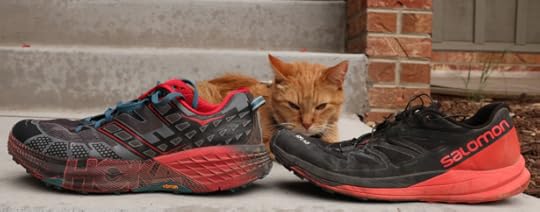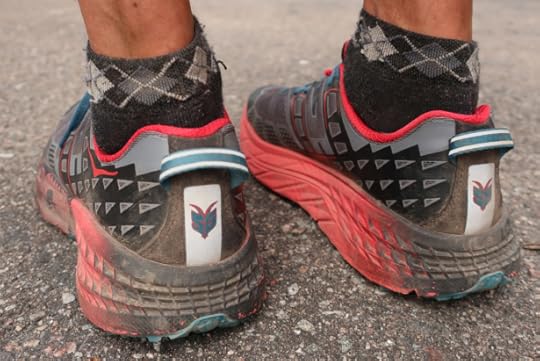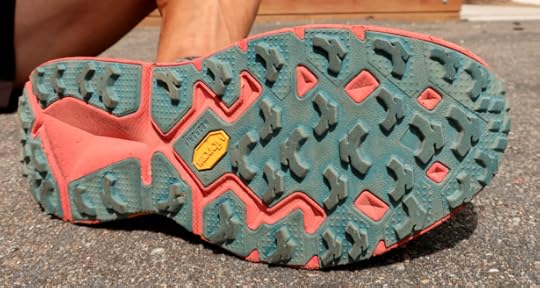Review: Hoka One One Speedgoat 2 || Light, plush, grippy & surprisingly stable


The Hoka One One Speedgoat 2, developed with superstar Karl Meltzler, is classic Hoka: light, cushy, and smooth-riding. It’s also grippy, and remarkably stable for its height.
On my first three outings with the second-generation Hoka One One Speedgoat 2, I took it out for 13-, 11-, and 25-mile trail runs with nearly 10,000 vertical feet in cumulative climbing. That’s rare for a shoe with which I had no prior history — normally, I start off slowly, with short and low-risk runs until the shoe is more proven. But this particular pair inspired confidence within minutes of slipping them on.
Review: Hoka One One Speedgoat 2
The Speedgoat 2 is a capable and forgiving trail shoe that excels on maintained trails with flat footing (e.g. benched side-hills, constructed staircases, and straightaways). It’s:
Lightweight, at 9.8 oz for men’s size 9 US;
Generously cushioned, with a stack height of 32 and 27.5 mm at the heel and forefoot, respectively;
Grippy, thanks to a Vibram MegaGrip outsole with 5 mm lugs; and,
Shockingly stable for its height, due to the reinforced upper, cradled foot bed, wide last (relative to the original model), and outsole.
I find the Speedgoat 2 best for easy and moderate efforts on trails. They’re not built for road-running, but a few miles of pavement mixed into trail runs are acceptable. They are dreamy for long runs, and a welcome break from thinner and more agile models like the Salomon Sense Ultra (my review) that are harder on my body but that ultimately I prefer for tough trails and fast efforts. For some runners and courses, the Speedgoat 2 could absolutely serve as an ultra trail marathon racing shoe.

The Speedgoat 2 and Salomon Sense Ultra, and BFF Oden. They are entirely different shoes, but currently two of my favorites. One goes fast but is hard on the body. The other is slower but more comfortable.
The Speedgoat 2 is discouraged for runners who:
Have wide and high-volume feet, or perhaps even average width and average-volume feet; and/or,
Prioritize ground feel, responsiveness, and low center of gravity over cushioning.
For instance, the Speedgoat 2 is not a good alternate for the Altra Lone Peak (my review) or La Sportiva Bushido (my review).
Hiking & backpacking
While it’s intended as a trail running shoe, I think the Speedgoat 2 will perform equally well for on-trail day-hikes and backpacking trips. I wouldn’t use them for a high route — they are too top-heavy and squishy for uneven footing, scrambles, and talus-hopping.
Caveat: I cannot yet attest to its long-term durability. I’m being purely speculative, but the outsole is my primary concern — it is wonderfully grippy, but a normal hiking shoe outsole has twice as much lug volume.
Please support this review by buying the Speedgoat 2 or other products from the vendors below.
Product specs
Weight: 9.80 oz (277 g) M’s 9 US, 11.0 oz (312 g) M’s 11.5 US
Stack height: 32 mm heel, 27.5 mm forefoot
Drop: 4.5 mm
Upper: Breathable mesh with TPU overlays
Midsole: Compression molded EVA
Outsole: Vibram MegaGrip with 5 mm lugs
Support: Moderate
More product specs
The Speedgoat 2 retails for $140.
Versus the original Speedgoat
The Speedgoat is new to me, so I don’t have the personal context to compare the original Speedgoat with v2. From what I understand, the most significant differences with the Speedgoat 2 are its wider last and more voluminous upper, which has resulted in improved stability and fit (for most feet, at least).
Otherwise, most elements remain the same: a breathable mesh upper reinforced with TPU, Vibram outsole, and thick midsole (v1 was 33 mm and 28 mm, with 5 mm drop).
Sizing
The Speedgoat 2 fits true to size. My review pair is size 11.5. I also wear 11.5 in Altra, Merrell, Salewa, and Salomon; I wear 45.5 in La Sportiva.
Fit
I have a narrow and small-volume foot, and the Speedgoat 2 fits me precisely, especially now that they have packed out some.
If you have wide and high-volume feet, forget about it.
If your feet are of average width and volume, give it a shot. The limiting factor will most likely be the toebox, which seems proportionally small relative to the midfoot and heel. Try a half-size larger, or a lacing method that allows you to tighten the midfoot independently of the forefoot.
Note that reviewers on the Hoka website consistently state that the Speedgoat 2 is too tight/narrow.
Ride
The Speedgoat 2 is classic Hoka. The marshmallowy midsole absorbs shock and small rocks. The rockered shape results in a smooth transition from impact zone to toe-off. And the deep-seated foot cradle helps offset the inherent instability of a 32-mm heel height. These diagrams accurately illustrate the Speedgoat 2 experience.
There are some tradeoffs to these features, however: it is relatively squishy and top-heavy. When I want a fast shoe, I reach for something more responsive and stable. It’s not that the Speedgoat can’t be fast — for instance, yesterday I set a PR on the descent of Bear Canyon (nearly 31 min). But the Speedgoat 2 struggles when it’s put on edge by twisty trails, side-hills, washed-out rock fields, and talus.

The Speedgoat 2 has a rockered outsole for smoother impact to toe-off transitions. It’s not a gimmick — it helps.
Upper
The upper is made of breathable mesh and features a TPU exoskeleton and toecap, which improves foot stability and resistance to abrasion, tears, and impact. I’m skeptical of any trail running shoe without an exoskeleton.
I’m not a fan of the elasticized linguine-shaped laces. They’re more difficult to tie than rounder laces, and the elastic is already failing to rebound fully.
When Hoka reexamines its laces, maybe it could consider an elasticized mid-foot yoke or tongue, too. This would partially decouple midfoot control and the tightness of the laces. Currently, when I crank on the laces to tighten the midfoot, it also tightens the toebox, which is tight enough already.
I haven’t worn them long enough to comment on durability. The uppers on my Clifton 2’s are perfectly intact after 550+ miles, and I’m hoping that Hoka used a similar formula for the Speedgoat.

The mesh upper is overlaid extensively with TPU panels and stripes for improved control, durability, and protection.
Outsole
This summer I’ve been impressed by three outsole rubbers: Salomon’s Premium Wet Traction Contragrip, La Sportiva’s FriXion, and now Vibram MegaGrip, which is spec’d on the Speedgoat 2.
The Speedgoat sticks reliably to rocks (even wet ones) in Boulder’s foothills, and it gets decent bite into hard-packed surfaces covered in ball bearing-like mineral sand. When on pavement, I can feel the lugs grip. Normally, grippiness and durability are inversely related, but I’ll have to post back on this one.

The Vibram MegaGrip outsole with 5 mm lugs is exceptionally grippy and helps to offset the inherent instability of a 31-mm tall shoe.
Buy now: Hoka One One Speedgoat 2
Have questions about or an experience with the Speedgoat 2? Please leave a comment.
Disclosure. This website is supported mostly through affiliate marketing, whereby for referral traffic I receive a small commission from select vendors, at no cost to the reader. This post contains affiliate links. Thanks for your support.
I was provided a pair of Speedgoat 2 for review my Hoka One One.
The post Review: Hoka One One Speedgoat 2 || Light, plush, grippy & surprisingly stable appeared first on Andrew Skurka.



